Introduction The practice of predicting the future has a long history, ranging from personal consultation in the patterns of coffee grounds to global computational projections derived from vast sums of data. The longing for a vision of the future offering some certitude seems to cross cultural boundaries. Engineer Alan Kay stated that “the best way to predict the future is to build it”. There are people who are doing this today. The Future Fabulators (FFab) [1] is an art and research project funded by the EU Culture Programme (2007-2013) in co-operation with the Education, Audiovisual and Culture Executive Agency. Future Fabulators is led by the Time’s Up [2], Linz based, art collective, in collaboration with FoAM [3], M-ITI [4] and AltArt [5]. As principal investigator at M-ITI, in this article I will describe the research and artistic developments of FFAb mainly from the M-ITI prospective although the project had been a thigh collaboration, where we often came together, confronted and challenged ideas, inspired and helped each other in many ways. The Future Fabulators intent moves beyond words and statistics to make possible futures tangible. Future Fabulators develops storyworlds in which the public can see and experience predicted and imagined futures in a way that they, as individuals and groups, might live them – replete with the beauty and banality of everyday life in an alternate world. Storytelling and story-listening have always been intertwined ways of understanding, explaining and creating the world. In this project we share these stories with trained futurists, storytellers and the public, our experts of everyday life, integrating their stories into experienceable narratives from which we all can learn about different visions, prejudices or habitual patterns that influence how we see the world and thus how we imagine our future. FFab uses techniques from physical narration, context-aware narrative, and future pre-enactment to translate future scenarios into storyworlds, which are built as immersive situations in public and private spaces and designed to be playfully explored and enacted by a broad population. In particular Future Fabulators at the Madeira Interactive Technology Institute focused particularly on conceiving, developing and evaluating mobile, context-aware, multimedia, and transmedia stories. We investigate the contemporary panorama of creative media and translate stories of the future into artifacts of the present. Our goal, in close synergy with our FFabs partners, is to unfold the potential of technology and storytelling, blending tangible narrative, interactive technologies, and future forecasting.
Future Fabulating at Madeira Interactive Technology Institute [6]
During the course of the two years project, at M- ITI we specifically conceived and produced three technologically mediated story artifacts, namely, Laurasilva, Yasmine Adventures, and the Dreamscope. Laurasilva was conceived as a transmedia story that would expose tourist of the Madeiran island to the rich heritage and biodiversity of the protected Laurisilva. Yasmine Adventures, is a context aware mobile story, developed in collaboration with the UDK Design Research group and the Jewish museum of Berlin, in order to connect the visitors of the museum to the surrounding neglected neighbourhood. Finally the Dreamscope, is a set of tools that complement the Lucid Peninsula installation, a truly inter disciplinary and collaborative effort of the Fabulators. Through the Lucid Peninsula future scenarios, physical narrative and context aware digitally mediated storytelling come together in an interactive and immersive installation that has already been exhibited in Austria, Romania and Scotland. The rest of the article will describe the three installation in details and reflect on them.
Laurasilva and the future of context aware eco storytelling
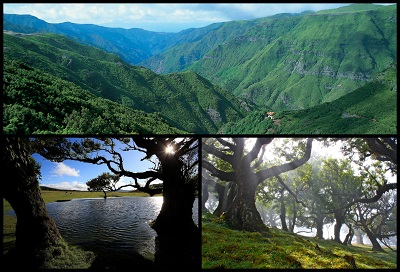
Humanity benefits in a multitude of ways from their surrounding natural ecosystems, but often are unaware of such benefits or choose to ignore them as they seem detached from their everyday lives. For this reason we conceived LauraSilva, a technologically mediated story aiming to create awareness, disseminate knowledge, and engage its audience in learning about the importance of the UNESCO-protected endemic Laurisilva forest of Madeira (See fig 1). The project takes the shape of a mobile-based, context-aware transmedia narrative that unfolds in the local village of Ponta do Sol. The audience explores the narrow alleyways in search of a lost 18th-century herbarium and the historic, cultural, and scientific knowledge it contains (See Fig.2).
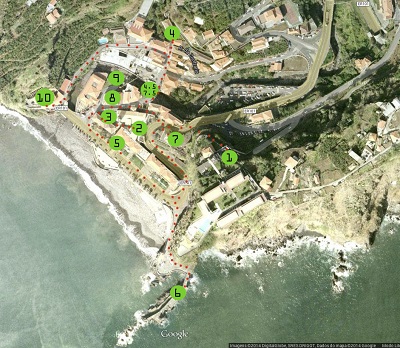
The story takes place in Madeira during the 18th century, when it served as a busy port for transatlantic trade. The protagonist, Laura Silva, is a young woman who escapes a difficult childhood in an orphanage to receive medical training from her adoptive father who is the village doctor. She stows away on a transatlantic voyage to escape scandal, but eventually returns to pursue her life’s work studying, cataloguing, and defending Madeira’s unique forest. Her notes and samples are kept in a vast herbarium – an annotated and illustrated book of medicinal plants – but Laura and the book go missing, apparently swept away in the historic flood of 1803.
The experience is mediated through a custom mobile application that provides location-aware sensing to guide the audience in its quest. The story unfolds through audiovisual content, text messages and interactive arte-facts placed around the village. Having completed the content and experience design and undergone its first iteration as an experience prototype, the project is currently in its technical development stage. In parallel to the story and interaction design of the experience we engaged our Fabulators colleagues in a future casting workshop entitled the future of Laurasilva (Fig. 3). The result of these two days brainstorming, forest walking and future scenario planning yelded three fantastic scenario for our context aware story audience to experience once they concluded the Laurasilva transmedia experience. The three scenarios are delivered through a mobile phone at the end of the quest for the herbarium. Depending on their engagement with the story our audience will be faced with a future based on Disciple, where humans protect nature and its biodiversity through strict laws and academic treaties. Such scenario will be going under the name of Botanocracy. Another possible future, the Transform scenario, is based on the total transformation of the status quo of the current reality of things, where the unimaginable will be possible, from flower based cars, to a life under water and magic remedies will be extracted from the powerful Laurisilva plants. The third possible future for the Laurasilva, the Collapse scenario, is dictated by the possible occurrence of a natural disaster of the magnitude of a tremendous earthquake followed by a powerful tsunami, which would disrupt all social organization and aloud nature to take over again (See Fig. 4 for visuals of the different scenarios).
By having a glimpse at these future we envisage our audience to be able to make mental notes, assumptions if not even plans on how to get there, or how to avoid them or simply become aware of the multiple possibilities that life has. Since things will not remain as they are forever, it is better to take charge of the future and chose where to go or not to. Quoiting William Gibson infact: “The future is already here, It is just not evenly distributed. “.
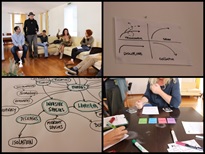

Yasmine Adventures
Yasmine’s Adventures, is a location aware multimedia story leveraging on urban computing strategies to create an interactive walk through the Mehringplatz area surrounding the Jewish Museum of Berlin. Yasmine’s Adventures follows a young local girl (Yasmine) through a series of short animated adventures, tailored specifically to engage visitors in exploring the relatively neglected streets of the area in which the museum is situated. Yasmine’s perceptions of the landmarks, identified by community members themselves, reflect the real concerns of the community. Results from the evaluation of the user’s experience suggest location connection and perception changes when locative media narratives include learning, understanding and discovery elements. Yasmine’s Adventures Interactive Experience was conceived with the goal of exposing non-residents of the Mehringplatz neighbourhood to its issues and attractions by encouraging them to see the area from the point of view of the community. The process originated with the ‘Pinpointing Mehringplatz’ workshops, in which local community members expressed opinions about features of the neighbourhood as pleasing, displeasing, or potentially transformational. Based on the issues raised by the community members themselves we then selected five anchor points in the local area and crafted the story of Yasmine so to touch all of the designated sites (See Fig 5). Yasmine is a fictional character, a curious and adventurous 7-year-old girl from the neighbourhood. She starts her adventure by escaping from a field trip to the Jewish Museum and walking home by herself. Along the journey she stops in various places, such as the Mehringplatz KMA, where hip hop classes are offered, or the popular street murals where she talks to the artist, who informs her about the history of such murals. But every journey has its challenges, and Yasmine faces some along her path. Yasmine’s Adventures echoes the positive as well as the negative feelings about neighbourhood locations in accordance to the content retrieved in the community workshop.
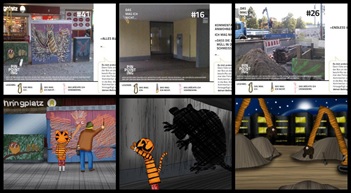
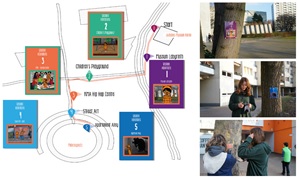
Audience response
We valuated of Yasmine Adventures on site with more than 20 users, shadowing them, asking them to fill in a survey and answer several question (See Fig.6). What we found is that the YA experience does promote relatedness and exploration of the local neighbourhood. The results indicate that participants did experience a sense of presence generated by the location aware multimedia story and this feeling allowed them to be immersed in the story. Participants revealed levels of immersion and transportation through the narrative, completed the task and felt absorbed by it, wishing to have extra visual markers and further information as they explored the space. In addition, this sense of presence enabled users to gain a greater awareness of the neighbourhood’s physical space but also about the people living in it. This awareness expanded to feeling empathy and a shared understanding for their local issues. In summary, the findings uncovered through the YA user study seem to suggest that locative media associated with urban computing is a successful strategy for generating engagement and connection to local communities. However, these digitally mediated sociocultural efforts, such as YA, need to go beyond the individual engagement of a few people and perhaps even expand over longer periods of time. In a nutshell, more than looking at individuals, users seem to suggest that having a community lens, looking at historical facts from a group perspective, and adding testimonials that allow others to understand the cultural and physical evolution of a particular location, would be a welcome output for a sociocultural-oriented LAMS. The connection of the audience with the local neighbourhood seems to increase when a treasure hunt experience is added to location aware multimedia stories. Such a result can be achieved by mixing content with search and discovery activities. Learning by being in the place as well as learning by discovering and connecting factual elements with the real location, and ideally having direct contact with the communities, seem to be the ideal ingredients for pleasurable and successful engagement of people in the discovery of socially marginalized, overlooked, or underprivileged neighbourhoods. Lucid Peninsula and the Dreamscope The last and most closely collaborative effort of the Fabulators project is the Lucid Peninsula (LP) artistic installation. LP is an interactive installation designed to immerse participants in a dreamlike, post-apocalyptic storyworld where changes to the Earth’s atmosphere have led to the emergence of new species, conditions, and ways of life. Fragments of memories and dreams belonging to the inhabitants of the previous era still linger in this new world, hovering over certain locations. The Lucid Peninsula storyworld where the lucid dreaming takes place emerged from a future scenario planning activity undertaken by artists and designers from the FoAM and Time’s Up collectives in June 2014. We worked closely with these artists to create the Lucid Peninsula interactive physical installation. The goal of the installation is to offer a means for people to experience the future by bringing to life a storyworld the audience can interact with, reflect on, and interrogate with questions such as: Could I live in this world? Could this really happen? How would I adapt? The Lucid Peninsula storyworld is a futuristic world that feels familiar, yet strange: an eternal twilight of dreamlike metaphors and shape-shifting beings. Environmental living conditions have radically changed and the search for green plants has become crucial for survival. The outside air is toxic: not immediately lethal, but requiring special gear and treatment after exposure. To give the public a chance to experience the Lucid Peninsula firsthand, we designed a physical installation and an interactive environment to function together and enhance each other. While the Time’s Up collective designed and built the recovery room, we designed and developed the interactive DreamScope tools, comprised of Dreamviewer binoculars and a mobile Dreamcatcher.
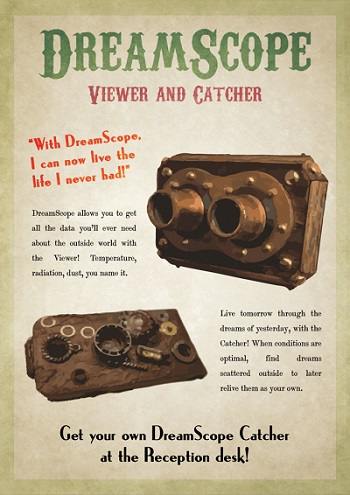
The equipment will be located in a special room, dedicated to the detoxification and recovery of air force pilots who sweep the peninsula in search of rare green plants, and need to undergo a special purification treatment before they can fly the next mission. On one side of the installation, the Dreamviewer binoculars will be positioned at a window so that users will be able to see the exterior world and try to gauge the viability of venturing outside again, taking into account data such as air toxicity, availability of plants, other life forms, etc. On the other side, the audience will be able to borrow mobile devices (Dreamcatchers) and venture into the real streets of the urban space in which the installation is hosted, in order to ‘catch’ the dreams of the inhabitants of the peninsula, which are mixed with memories of the world before it was transformed into the dry and toxic Lucid Peninsula that it has become. The Dreamscope tools will guide people in the discovery of this world.
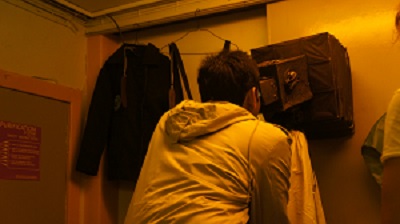
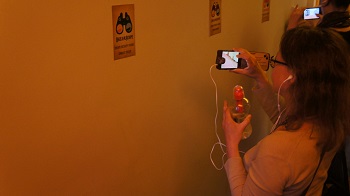
The Lucid Peninsula was successfully exhibited in Austria and Romania, in the context of the exhibition Intime Raume 2014 by IMA and Future Fabulators exhibition by AltArt and as interactive installation at the C&C art track in Glasgow (ref). The installation will keep travelling after the summer. Keep an eye on Vienna around the 8th of October.
Conclusions
As Future Fabulators comes to an end, at least that part of Future Fabulators (FFab) which was supported by the Culture Programme of the European Union, everything else, like the project base, the collaborations and joint ventures will keep flourishing and already have been grown into new project-sketches and tangible, solid project outlines. We are really looking forward to keep working with partners and associates of FFab to keep concentrating on topics growing important while the last two years. Because as “If there is to be a future”, as Peter Thiel, the founding CEO of PayPal, “we would do well to reflect about it more.”.
ACKNOWLEDGMENTS
We wish to acknowledge the EU Culture and Media Project Funds for sponsoring our investigation, our fellow researchers at all partner institutions, M-ITI, Time’s Up, and FoAM for their help and contributions, and the LARSyS research group for support and funding. Project Participants and References
[1] http://timesup.org/FutureFabulators
[2] Founded in 1996, Time’s Up has its principal locus in the Linz harbour of Austria. Its mission is to investigate the ways in which people interact with and explore their physical surroundings as a complete context, discovering, learning and communicating as they do. http://timesup.org/
[3], FoAM is a network of transdisciplinary labs for speculative culture. It is inhabited by people with diverse skills and interests – from arts, science, technology, entrepreneurship, cooking, design and gardening. It is a generalists’ community of practice working at the interstices of contrasting disciplines and worldviews. http://fo.am/
[4] AltArt is an NGO that promotes digital culture and aims to strengthen the Romanian cultural sector. AltArt contributes to promoting the impact of culture on societal development through research, debates, networking and policy work. http://www.altart.org/
[5] The Madeira-ITI operates in the interdisciplinary domain of human-computer interaction encapsulating contributions from computer science, psychology and design in order to address/engage in important scientific and technological challenges that are both relevant to society and have significant economic impact. http://www.m-iti.org/
[6] http://futurefabulators.m-iti.org/


